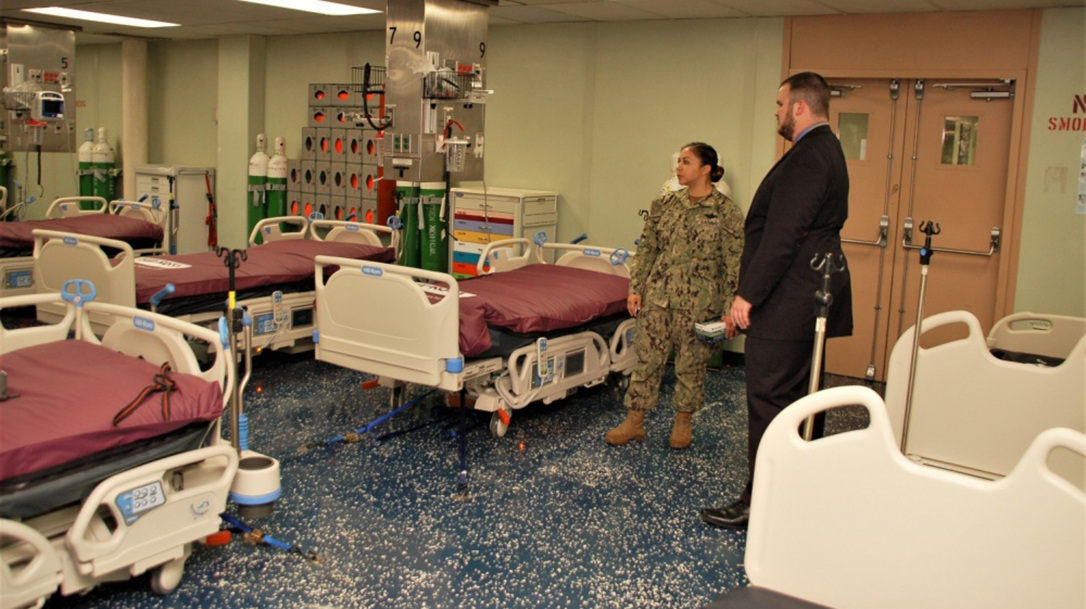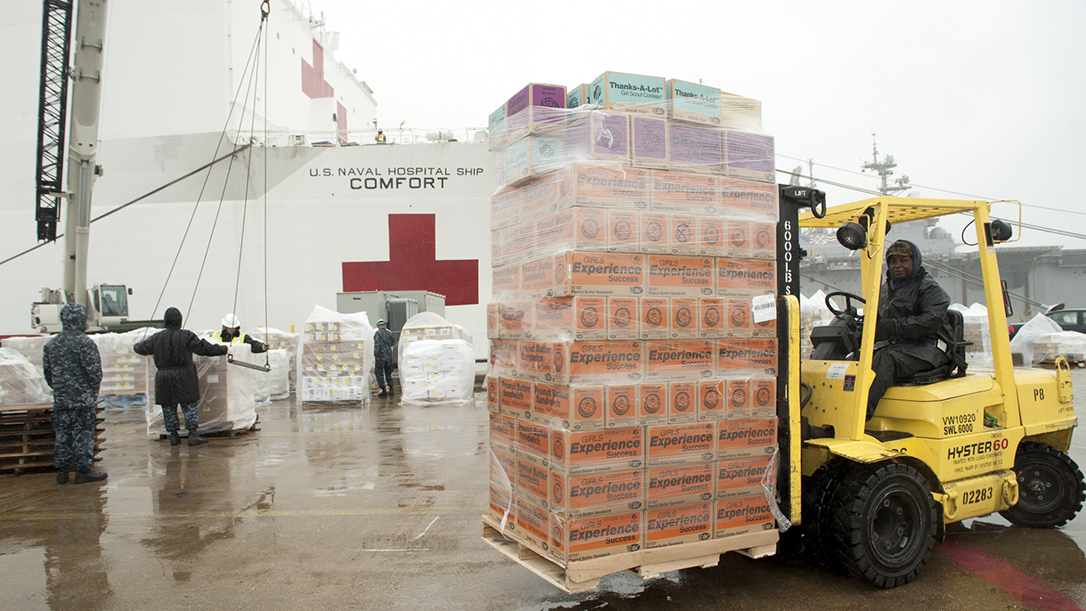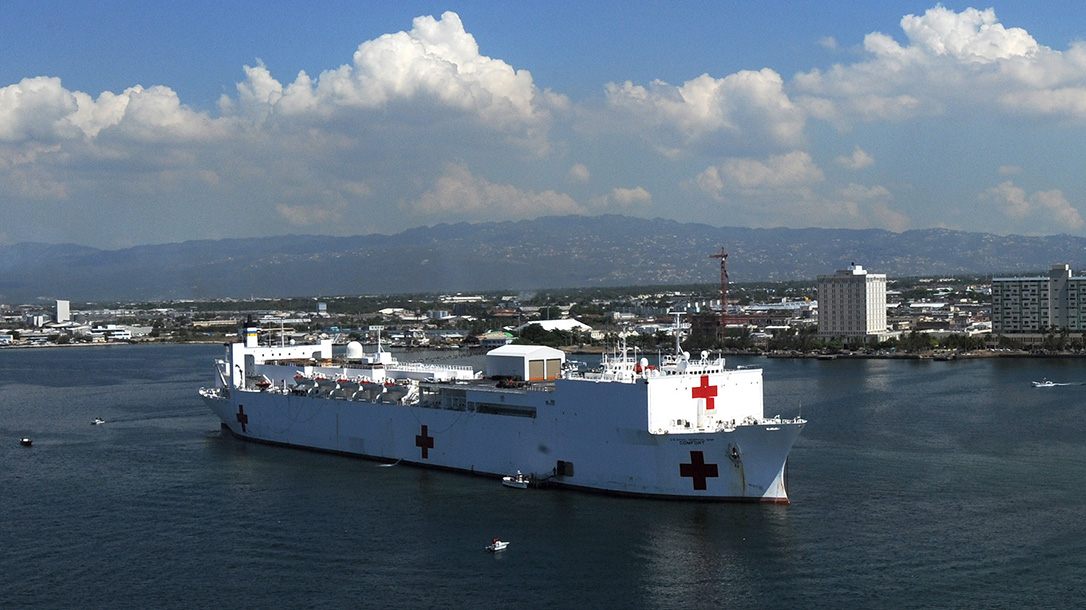Right now, the largest hospital ships in the world are making steam to come to the aid of both U.S. coasts. California and New York face an onslaught of new COVID-19 patients, with no end in sight. As big city hospitals in the U.S. strain under the inundation of new COVID-19 patients, resources must come forth t to alleviate some of that burden. Half of U.S. city hospitals have less than 100 beds, while the largest hospitals, such as New York’s Beth Israel, can accommodate around 1,000 patients.
Life Inside a U.S. Navy Hospital Ship
In a press interview earlier in the week, New York Governor Andrew Cuomo stated: “We don’t have the capacity in the hospitals, we don’t have the ventilators, you can’t find enough ventilators. I have people in China right now trying to buy ventilators.” The lack of beds came to the forefront of the interview: “Right now, in New York specifically, the rate of the curve suggests that in 45 days we could have up to an input of people who need 110,000 beds that compares to our current capacity of 53,000 beds, 37,000 ICU units, ventilators, which compares to a capacity currently of 3,000 ventilators. That’s our main issue.”
Advertisement — Continue Reading Below
This main issue remains the problem facing hospitals all over the country, especially those in smaller cities, ones not used to this kind of hospital admittance rate. To help relieve the pressure placed on the nation’s medical establishment, the U.S. Navy is ramping up readiness of its only two hospital ships, USNS Mercy and USNS Comfort. Though they can only offer a maximum 2,000 beds between them, they bring with it the full force of the Navy’s medical experience.
USNS Mercy (T-AH-19)
Mercy began life as a San Clemente-class oil tanker named the SS Worth in 1976. Converted to a hospital ship over the course of nearly three years, the Navy placed her into service in 1986. At 894 feet long and 65,552 tons displacement, she is part of the third largest class of ships in the U.S. Navy. Under normal circumstances, she keeps port in San Diego and is part of the Naval Medical Center. When ordered to sea, she has only five days to become fully active as a NATO Role III Medical Treatment Facility, second to none on the ocean, going from having only 70 personnel onboard (in reduced operation status) to nearly 1,300. She carries no defensive weapons, but any nation firing upon her is tantamount to a declaration of war.
Though her theater of operations is the Pacific Ocean, Mercy did assist with Desert Storm in 1990. She saw action during the South East Asia earthquake and tsunami in 2004 and other natural disasters around the Pacific Rim. Now she will depart to Seattle on Monday to assist area hospitals.
Advertisement — Continue Reading Below
USNS Comfort (T-AH-20)
Much like the Mercy, the USNS Comfort serves in the Navy’s Military Sea Lift Command, a series of ships that are non-commissioned but owned by the U.S. Navy. The ships are operated, navigated, and maintained by a civil service mariner staff, or CIVMAR. These are federal government employees but not U.S. Navy personnel. The Navy command is responsible for the hospital and its staff.
Originally laid down as the SS Rose City, a San Clemente-class oil tanker in 1976, she was converted to a hospital ship in 1987. At 69,360 tons displacement, she is slightly larger than her sister, but they are identically-designed ships. She provided aid during the Gulf War and the Iraq War. At home, she sat in port at New Orleans for nearly two months treating patients after Hurricane Katrina, and was sent to offer assistance following the Haiti earthquake. The Comfort, docked in Norfolk, Virginia, since 2013, currently undergoes needed maintenance, which may take weeks. However, that effort is being expedited so she can be deployed to New York City harbor in preparation to aid the East Coast during the COVID-19 pandemic.
The Hospital Ships’ Mission Status
According to Naval Command, Mercy’s and Comfort’s primary mission is to “provide rapid, flexible, and mobile acute medical and surgical services to support” U.S. deployments around the world. Whereas, their secondary mission, one that they are currently being readied for, is to provide “mobile surgical hospital service for use by appropriate U.S. Government agencies in disaster or humanitarian relief.”
Advertisement — Continue Reading Below
“The deployment of the USNS Comfort to New York is an extraordinary but necessary step to help ensure our state has the capacity to handle an influx of patients with COVID-19 and continue our efforts to contain the virus,” Cuomo said in a statement.
Each ship will not treat COVID-19 patients directly. Instead, they will help lesson the burden of emergency rooms by treating trauma patients (and other illnesses). Those cases would normally take up beds needed for treating COVID-19 patients. Because the 1,000 beds on each ship typically reside in open bays and not contained areas, the ships remain ill-equipped to handle infectious disease cases. “Our capabilities are focused on trauma,” Defense Secretary Mark Esper said. “Whether it’s our field hospitals, whether it’s our hospital ships, they are focused on trauma. They don’t have necessarily the space, the segregated spaces, to deal with infectious disease.”
Two Army units will also deploy with the ships to help treat non-infectious patients. The 47th Combat Support Hospital comes from Joint-Base Lewis-McChord in Washington state. Meanwhile, the 586th Field Hospital hails from Fort Campbell, Kentucky.
Advertisement — Continue Reading Below
Inside Mercy and Comfort
With a total complement of 1,000 beds each, Mercy and Comfort are nearly identical in their capacities and abilities to offer aide and relief to the pandemic victims. Although each ship includes burn treatment facilities, causality triage centers, and 12 operating rooms with 80 intensive care beds, each must undergo transformation to treat the maximum number of patients as possible.
Both ships have side ports to take on patients at sea as well as helicopter decks for air transport. They have 12 fully-equipped operating rooms, digital radiological services and a medical laboratory. A pharmacy, optometry lab, CAT-scan and two oxygen-producing plants complete the facilities. Overall, each ship is capable of treating nearly any type of trauma situation. Mercy’s crew consists of 61 civilians and 1,200 hospital personnel. Meanwhile, Comfort includes 63 civilians and nearly 1,000 hospital staff, both mostly from the Navy’s Medical Corps.
Advertisement — Continue Reading Below
The Navy Surgeon General, Rear Adm. Bruce Gillingham told reporters on March 19: “Although this is not our traditional medical mission, which typically involves combat casualty care, I believe these efforts demonstrate our agility and responsiveness to do what the country asks, wherever and whenever we’re needed.”


























